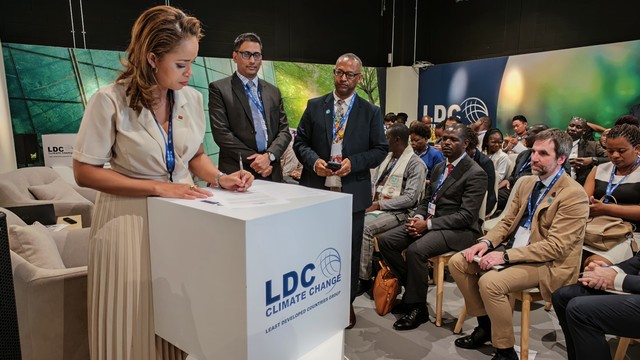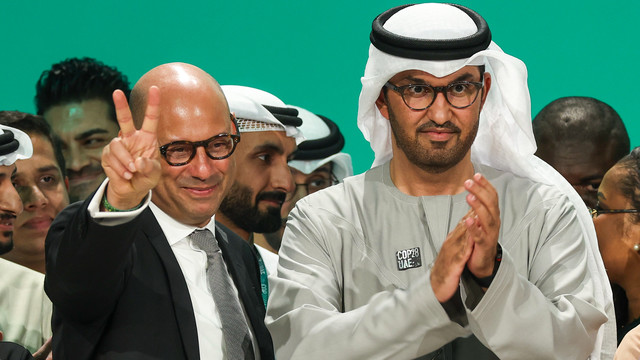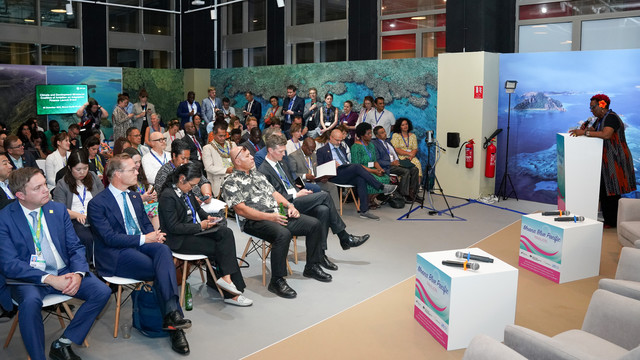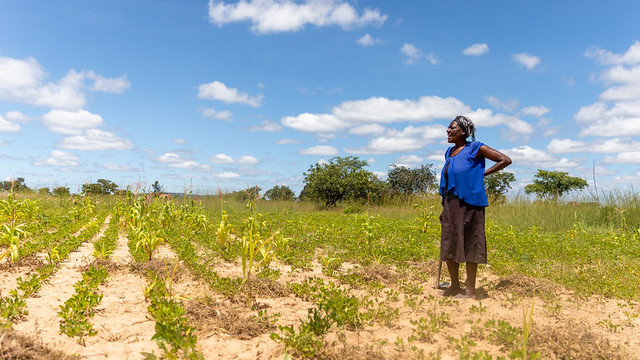Progress towards gender balance at the UN climate negotiations: slow, steady – but not enough
Stella Gama looks back to the early calls to address the heavy underrepresentation of women at the international climate summits. Given the mixed bag of progress to date, Gama asks: what’s slowing things down?


Delegates at a loss and damage event during COP26 in Glasgow (Photo: Justin Goff/UK Government via Flickr, CC BY-NC-ND 2.0)
The UN Framework Convention on Climate Change (UNFCCC) on its inception at the 1992 Rio Summit was labelled ‘gender blind’.
There has been incremental progress since then to move towards gender balance within the convention’s processes, starting with the final decision text that emerged from the 2001 Marrakesh climate negotiations introducing women participation and representation. The next milestone came in 2012 in Doha, committing Parties to promote gender balance along with accompanying targets.
Agreement to further gender-focused programmes and plans at subsequent climate summits (see text box) have achieved the following:
- Significant strides to advance gender mandates across all relevant areas in the climate negotiation
- Steady but slow progress on the goal of gender balance and women representation at the climate negotiations, and in the UNFCCC’s subsidiary bodies and constituted bodies, and
- Increased awareness of the need for gender balance in the response to climate change.
Achieving the goal of gender balance: a mixed bag
Given this progress, we now celebrate an increased number of women being part of their national delegations at the climate negotiations and participating in UNFCCC processes – although noting these increases are still relatively modest.
According to WEDO’s Gender Climate Tracker, in 2009, women made up 30% of national delegations and 38% in 2021. In 2022, 46% of participitants at the climate intersessional (the mid-year climate negotiations that are typically more technical in nature) were women, while 35% at the COP summit in Sharm el-Sheikh were women.
In 2012, 21% women were head of delegations – although by the Paris COP in 2015, this figure had dropped, with only 9% of the delegations being led by women. COP23 in 2017 saw the highest number to date, when over a quarter of delegations (26%) were headed up by women. In 2022 it had dropped to a fifth.
So, some signs of progress but clearly much still to be done.
We should celebrate those women being nominated to lead processes; those being nominated as facilitators; the women chairing subsidiary bodies and groups of Parties. And there are many other women taking on other leadership positions. Yet we are still falling far short: in constituted bodies, only 10 out of 17 have 35% or more female members, and there are still too few women leading these bodies.
Back in Doha, when we called for gender balance, we were optimistic and ambitious. Over ten years has passed: it’s clear we are not progressing enough, or quickly enough.
More work needs to be done. We need more advocacy, more practical steps and policy measures, and affirmative action.
What’s slowing progress?
Achieving gender balance requires an understanding and unequivocal acceptance of the basic concept that women are equal. It also requires understanding gender terms and the links between gender and climate change.
As I highlighted earlier, the UNFCCC was gender blind on its inception. Over the years the convention has faced problems with the use of certain language: the term ‘gender equality’ itself was challenged by some Parties.
The Lima Work Programme on Gender marked a turning point, setting out specific, measurable ways to promote gender balance across all areas of the UNFCCC and at national level. Nonetheless, it is noteworthy that the term ‘gender equality’ was not used again by the UNFCCC until it featured in the preamble of the Paris Agreement.
To advance discussions, countries need to find common ground and areas of agreement.
With the adoption of the Lima Work Program and the Gender Action Plan, all Parties have committed to implement actions to advance gender-responsive climate policies at national and local level. Countries need to set their own plans with objectives and activities on how they will achieve gender responsive climate policy and action.
The challenge now is implementing these gender mandates. The underlying causes underpinning slow progress are many, but include inadequate understanding of gender mainstreaming and its processes – including monitoring.
Secondly, inadequate financing for the Gender Action Plan to support women empowerment activities and for country level initiatives and actions – as discussed recently by my colleague Winifred Masiko.
Gender balance is not a ‘nice-to-have’
For Parties to the UNFCCC, action to achieve gender balance is a commitment. Countries commit to reduce emissions, they commit to report on those emissions, and they commit to report in a transparent way and so on. Alongside such commitments, countries have a commitment to take action to achieve gender balance.
Too often, the goal of gender balance is viewed separately, or sidelined, or as a ‘nice-to-have’. But for lasting, meaningful progress, the commitment to achieve gender balance must be at the centre of all action and decision making within the UNFCCC and related national policies.
Next stop, COP28; big moment, COP29
For advancing gender equality with the UNFCCC, COP29 next year is the big moment − when Parties will review the Lima Work Programme and the five-year Gender Action Plan.
But there is plenty to progress at COP28 including dialogues on the UN’s role in gender and climate change, and on gender-based budgeting.
Parties are expected to provide additional guidance on how they are implementing their gender and climate change targets.
Measures to catalyse progress included:
- Establishing quotas for gender balance and rotations for leadership positions
- Providing additional guidance on how UN entities could enhance coordination and support Party led actions, and how they can strengthen integration of gender and climate change in their work
- Enhancing the role of gender focal points, and
- Developing a clear roadmap for reviewing the Lima Work Programme and the Gender Action Plan.
As we approach COP29, Parties may make submissions on what they have achieved since the adoption of the enhanced Gender Action Plan and lessons learnt. Guidance coming out of COP28 will be an important stepping stone toward this.



